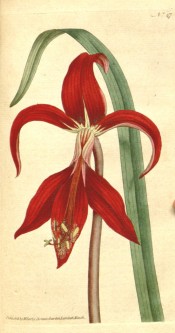Sprekelia formosissima (L.) Herb.
Half-hardy bulbous perennial with strap-shaped leaves and solitary, bright scarlet to deep crimson lily-like flowers in spring. To 35 cm. A reliable plant in the open garden in most of Australia. [RHSE, Hortus, Baker Am.].
Horticultural & Botanical History
First botanically described by Linnaeus in 1753 as Amaryllis formosissima [Sp. Pl. p.293/1753] and placed in Sprekelia by William Herbert in 1821: ‘I had wished to call this genus Jacobaea, a name to which the public have been long used, but it was called Sprekelia by Heister, though I am not aware that the name has been adopted, and I have therefore thought it right to adhere to that already given to it.’ [Herbert’s Appendix p.35/1821].
‘A native of South-America: according to Linnaeus, first known in Europe in 1593, figured by Parkinson in 1629, and placed by him among the Daffodils; stoves and greenhouses were then unknown, no wonder therefore it did not thrive long. Is now become pretty common in the curious gardens in England, and known by the name of Jacobaea Lily; the roots send forth plenty of offsets, especially when they are kept in a moderate warmth in winter; for the roots of this kind will live in a good green-house, or may be preserved through the winter under a common hot-bed frame; but then they will not flower so often, nor send out so many offsets as when they are placed in a moderate stove in winter. This sort will produce its flowers two or three times in a year, and is not regular to any season; but from March to the beginning of September, the flowers will be produced, when the roots are in vigour. It is propagated by offsets, which may be taken off every year; the best time to shift and part these roots is in August, that they may take good root before winter; in doing of this, there should be care taken not to break off the fibres from their roots. They should be planted in pots of a middling size, filled with light kitchen-garden earth; and, if they are kept in a moderate degree of warmth, they will produce their flowers in plenty, and the roots will make great increase.’ [BM t.47/1787, quoting largely from Miller’s Garden Dictionary]. MB p.149/1834.
History at Camden Park
Listed in all published catalogues [B.417/1843]. Probably received per ‘Sovereign’ February 1831 as Amaryllis jacobaea [MP A2948]. Amaryllis jacobaea Karsch was not described until 1853 but this name may well have been used much earlier. Still present in the gardens.
Notes
Published May 15, 2009 - 04:51 PM | Last updated Aug 09, 2012 - 05:18 PM
| Family | Amaryllidaceae |
|---|---|
| Category | |
| Region of origin | Central America |
| Synonyms |
|
| Common Name | Aztec lily, Jacobean lily, St James’ lily |
| Name in the Camden Park Record | Spreckelia formosissima
|
| Confidence level | high |


